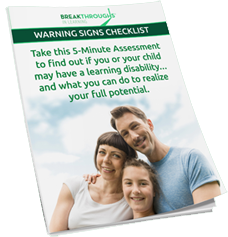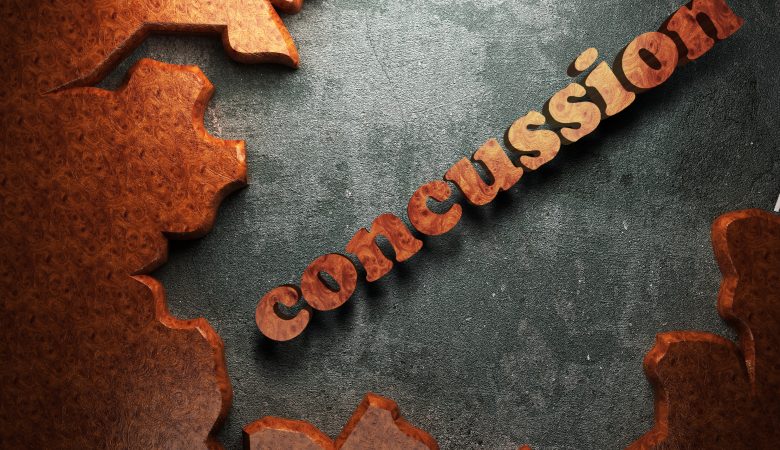
Does it affect life at home, at school or at work?
Take 5 minutes to complete the Warning Signs Checklist and discover whether you or your child could have learning difficulties that are impacting your life, and what to do about it.
Take The Free Warning Signs Checklist!
Concussions are often called the “invisible injury.” From hard-hitting football games and wrestling to the harmless-appearing activity of hitting soccer balls with the head, children have many opportunities to sustain head injuries while playing. However, the symptoms of concussion are not necessarily obvious right away and children will often mask symptoms in order to continue playing.
Concussions can contribute to long term impacts that affect comfort, functioning and learning. To prevent these impacts, you need to recognize the symptoms of concussion so you can facilitate your child’s recovery as soon as possible.
What is a concussion?
A concussion is basically the impact of the brain against the skull. It occurs when there is a blow, jolt, or bump to the head after a fall or hit. The jarring motion sustains an injury to the brain that is similar to a bruise and the injury slows down neurological processes. Simple tasks may become difficult and reaction time and memory slow down.
These injuries are not limited to rough contact sports. 60% of college soccer players and 10% of all high school athletes have suffered concussions. Currently there is a large body of research studies looking at the effect of sub-concussive events. These are much harder to detect as there are few symptoms and are often re-occurring in sports because they are often not recognised. Their total effect can be even larger than a concussion.
What are the symptoms?
Be aware that a child does not have to lose consciousness to have suffered a concussion. Very few concussions are a result of being “knocked out.” It can take surprisingly little to cause a concussion.
After an impact to the head, initial symptoms may include headaches, dizziness, memory loss, and nausea. Children may appear “loopy” and seem unengaged in their present activity. However, children may also push themselves to be re-engaged so they can continue playing. If after re-engaging, your child seems uncoordinated or unable to make decisions, pull them from play and visit the doctor. Those changes may indicate brain injury from a concussion.
Over the next few hours, and into several days, symptoms include light-headedness, poor concentration, headaches, neck pain, fatigue and complaints of sounds being too loud or lights being too bright. For children, controlling emotions may become difficult and irritability increases.
Symptoms may intensify within the next few days or new symptoms will arise. School work or any other mentally or physically strenuous activity may worsen symptoms.
Children who suffer migraines, learning disabilities, attention deficit issues, or mental health conditions often show more intense symptoms and recovery time may be longer.
How to proceed with a suspected concussion
Call emergency services if there are seizures, vomiting, and substantial memory loss. However, less severe symptoms can often be addressed by your primary care physician. Seek medical care immediately if a concussion is suspected.
Your child’s doctor will ask several questions about the facts of the injury and your child’s symptoms. The doctor’s exam tests head-and-neck motion, balance, eye movement and cognition. Memory games and computerized tests may be involved. Concussions cannot be diagnosed with brain imaging.
If it becomes apparent that your child suffered a concussion, it is likely the doctor will have the child stay home from school to rest. During this time, do not expect too much of your child and watch for new or worse symptoms. Your child may sleep too much, or too little, and continue to be irritable. If symptoms do not improve, contact your child’s doctor immediately.
As symptoms improve, cognitive activities may increase gradually. Your child may be able to return to school part-time, for example. However, if your child is only able to tolerate learning in 15-minute increments, be prepared to perform school work at home at your child’s post-concussion pace.
While concussions are serious injuries and require time to heal, the effects are often temporary if treatment is followed. The sooner treatment starts, the sooner your child will feel better. Repeated head injuries can have a stacking effect and have longer lasting side effects. If your child doesn’t bounce back to their normal self and school continues to be a struggle, working with an Educational Therapist can help rebuild the skills damaged by the concussion. For more information on how Breakthroughs can help you or your child recover from a concussion schedule a free consult today.
Subscribe to our newsletter and receive regular articles and resources to help you or your child perform better at school, home or work.
suscribe now
Post Your Comment Below